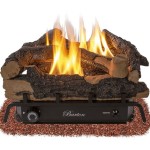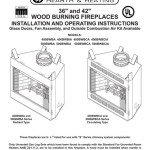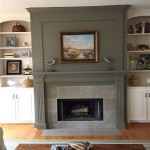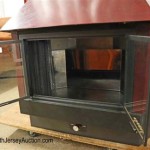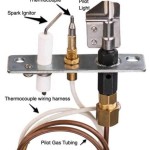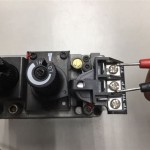Clean Indoor Fireplace Brick: A Comprehensive Guide
Maintaining a clean fireplace is crucial for both aesthetic appeal and optimal performance. Over time, fireplace bricks accumulate soot, creosote, and ash, leading to a dull and unattractive appearance. Furthermore, buildup can potentially pose a fire hazard and reduce the efficiency of the fireplace by hindering heat reflection. This article provides a detailed guide on effectively cleaning indoor fireplace brick, covering various methods and preventative measures.
Understanding Fireplace Brick Stains and Deposits
Before embarking on the cleaning process, it is essential to understand the types of stains and deposits commonly found on fireplace bricks. Soot, a black powdery substance, is a primary byproduct of incomplete combustion. It adheres readily to the brick surface, creating a dark, unsightly layer. Creosote, a more complex and hazardous substance, is a tar-like deposit that forms when wood smoke condenses in the chimney. Creosote is highly flammable and poses a significant fire risk if allowed to accumulate. Ash, the residual material from burned wood, while less problematic than soot or creosote, can still contribute to a grimy appearance.
The composition and porosity of the brick itself also influence the severity of staining. Porous bricks tend to absorb more soot and grime, making them more challenging to clean. Additionally, the type of wood burned in the fireplace can impact the amount and type of deposits. Softwoods, such as pine, tend to produce more soot and creosote than hardwoods, such as oak or maple.
Regular cleaning is vital to prevent excessive buildup of these deposits. Neglecting fireplace maintenance can result in stubborn stains that are difficult to remove and may require more aggressive cleaning methods. It is recommended that fireplaces used frequently are cleaned at least once a year, preferably before the heating season begins.
Essential Tools and Safety Precautions for Fireplace Brick Cleaning
Proper preparation is key for safe and effective fireplace brick cleaning. Gathering the necessary tools and understanding the recommended safety precautions is essential to minimizing risks and ensuring a successful outcome.
Begin by assembling the following tools: a stiff-bristled brush (preferably with synthetic bristles to avoid damaging the brick), a vacuum cleaner with a hose attachment, a sponge or scrub brush, a bucket, protective gloves, safety glasses, and a drop cloth or plastic sheeting. Depending on the chosen cleaning method, additional supplies may include a spray bottle, trisodium phosphate (TSP), dish soap, water, and a masonry cleaner specifically designed for fireplace brick.
Prior to initiating the cleaning process, prioritize safety. Wear protective gloves and safety glasses to prevent skin and eye irritation from cleaning solutions or dislodged debris. Ensure adequate ventilation by opening windows or doors. Cover nearby furniture and flooring with a drop cloth or plastic sheeting to protect them from splashes and spills. If using harsh cleaning chemicals, consider wearing a respirator to avoid inhaling fumes.
Carefully follow the instructions provided on any cleaning product used. Avoid mixing different cleaning chemicals, as this can create hazardous fumes. Test any cleaning solution on a small, inconspicuous area of the brick before applying it to the entire surface to ensure it does not cause discoloration or damage. When working inside the fireplace, use a stable platform or ladder to reach high areas safely. Before starting, ensure the fireplace is completely cool to prevent burns.
Effective Cleaning Methods for Indoor Fireplace Brick
Several methods can be employed to clean indoor fireplace brick, ranging from simple solutions to more intensive treatments. The most appropriate method will depend on the severity of the staining and the type of brick. It is always advisable to start with the gentlest method and progress to more aggressive techniques only if necessary.
Dry Cleaning: Before applying any cleaning solutions, begin by dry cleaning the brick surface. Use a stiff-bristled brush to remove loose ash, soot, and debris. Pay particular attention to crevices and corners where buildup is more likely to accumulate. Follow up with a vacuum cleaner using the hose attachment to suction away the dislodged particles. This step helps to prepare the surface for wet cleaning and prevents the solution from becoming overly contaminated with debris.
Soap and Water: For light to moderate staining, a simple solution of dish soap and warm water can be effective. Mix a small amount of dish soap with warm water in a bucket. Using a sponge or scrub brush, apply the solution to the brick surface and scrub gently. Avoid using excessive amounts of water, as this can saturate the brick and potentially cause damage. Rinse the brick thoroughly with clean water to remove any soap residue. Allow the brick to air dry completely before using the fireplace.
Trisodium Phosphate (TSP): TSP is a powerful cleaning agent that can effectively remove stubborn soot and grime. However, it should be used with caution, as it can be harsh and potentially damaging to certain types of brick. Mix TSP with water according to the manufacturer's instructions. Always wear protective gloves and eye protection when working with TSP. Apply the solution to the brick surface using a sponge or scrub brush. Allow it to sit for a few minutes to penetrate the stains, then scrub thoroughly. Rinse the brick thoroughly with clean water to remove all traces of TSP. TSP is a strong alkaline cleaner, so be sure to neutralize any remaining residue with a mild acid solution, such as diluted vinegar, before allowing the brick to dry. Always research the compatibility of TSP with your specific type of brick before use.
Masonry Cleaner: Several masonry cleaners are specifically formulated for cleaning fireplace brick. These cleaners are typically available at hardware stores and home improvement centers. Choose a cleaner that is appropriate for the type of brick in the fireplace. Follow the manufacturer's instructions carefully when applying the cleaner. Most masonry cleaners require application to the brick surface, followed by a period of dwell time to allow the cleaner to penetrate the stains. After the dwell time, scrub the brick thoroughly and rinse with clean water. Always test the cleaner on a small, inconspicuous area of the brick before applying it to the entire surface.
Vinegar and Baking Soda Paste: For a more natural cleaning solution, a paste made from vinegar and baking soda can be effective. Mix baking soda with vinegar to form a thick paste. Apply the paste to the stained areas of the brick and allow it to sit for several hours or overnight. This allows the baking soda to absorb the stains and the vinegar to help break them down. After the dwell time, scrub the brick with a scrub brush and rinse thoroughly with clean water.
Steam Cleaning: Steam cleaning can be an effective and environmentally friendly way to clean fireplace brick. The high-temperature steam loosens dirt and grime without the need for harsh chemicals. Use a steam cleaner with a brush attachment to apply steam to the brick surface. Scrub the brick as you steam clean to remove stubborn stains. Wipe the brick down with a clean cloth to remove any excess moisture.
Sandblasting: Sandblasting is a more aggressive cleaning method that should be used as a last resort. This method involves using compressed air to propel abrasive particles, such as sand, against the brick surface to remove stains and deposits. Sandblasting can be effective for removing very stubborn stains, but it can also damage the brick if not done properly. It is recommended to hire a professional sandblasting contractor to perform this service. Sandblasting can alter the texture and appearance of the brick, so it is important to consider the aesthetic impact before proceeding.
After cleaning, inspect the brick for any cracks or damage. Repair any damage promptly to prevent further deterioration. Consider applying a sealant to the brick surface to help protect it from future staining and make it easier to clean.
Preventative Measures for Fireplace Brick Maintenance
Maintaining clean fireplace brick involves more than just periodic cleaning; it also requires implementing preventative measures to minimize future staining and buildup. These measures can significantly reduce the frequency and intensity of cleaning required, prolonging the lifespan and aesthetic appeal of the fireplace.
Burn Seasoned Wood: Burning seasoned wood is crucial for reducing soot and creosote formation. Seasoned wood has a moisture content of 20% or less, which allows it to burn hotter and more completely. This results in less smoke and fewer deposits. Avoid burning green or unseasoned wood, as it contains higher moisture levels and produces significantly more smoke. Store wood in a dry, well-ventilated area to promote proper seasoning. A moisture meter can be used to check the moisture content of the wood before burning.
Regular Chimney Sweeping: Schedule regular chimney sweeping to remove accumulated creosote and soot. A qualified chimney sweep can inspect the chimney for potential problems, such as cracks or blockages, and remove any hazardous deposits. The National Fire Protection Association (NFPA) recommends having chimneys inspected and cleaned at least once a year.
Use a Fireplace Grate: A fireplace grate elevates the wood off the floor of the firebox, allowing for better airflow around the logs. This promotes more complete combustion and reduces the amount of smoke and soot produced. Choose a grate that is appropriately sized for the fireplace and designed to provide adequate airflow.
Practice Proper Burning Techniques: Load the fireplace properly to ensure efficient burning. Avoid overloading the fireplace with too much wood, as this can restrict airflow and lead to incomplete combustion. Position the logs so that there is adequate space between them for air to circulate. Build the fire in a way that promotes a hot, clean burn. Consider using the top-down burning method, where the kindling is placed on top of the larger logs, to reduce smoke emissions.
Maintain Proper Ventilation: Ensure the fireplace damper is fully open before lighting a fire. This allows for proper ventilation and prevents smoke from backing up into the room. If the fireplace has a glass door, keep it slightly ajar during burning to provide adequate airflow. Inspect and clean the damper regularly to ensure it is functioning properly.
Address Draft Issues: Draft issues can cause smoke to spill into the room and contribute to excessive soot buildup on the fireplace brick. If the fireplace has a weak draft, consider installing a chimney cap or a draft inducer. A chimney cap helps to prevent downdrafts and keep rain and debris out of the chimney. A draft inducer is a fan that helps to create a stronger draft in the chimney. Consult with a qualified chimney professional to diagnose and address any draft issues.
By understanding the causes of fireplace brick staining and implementing these preventative measures, homeowners can significantly reduce the need for frequent and intensive cleaning, maintaining a clean and safe fireplace for years to come.

How To Clean A Fireplace Diy Basics

Best Way To Clean A Fireplace Stacy Risenmay

How To Clean A Brick Fireplace With Scrubbing Bubbles 2024 Today S Homeowner

How To Clean Brick Fireplaces Mantels Hearths And More My Space

Mortar Wash Brick Fireplace Makeover Dimples And Tangles

How To Clean Fireplace Bricks 9 Steps With S Wikihow

How To Clean Fireplace Bricks Simple Practical Beautiful

How To Clean Fireplace Bricks

Fireplace Cleaning Tutorial Kippi At Home

How To Clean Fireplace Bricks Quickly And Effectively Lovetoknow
Related Posts

